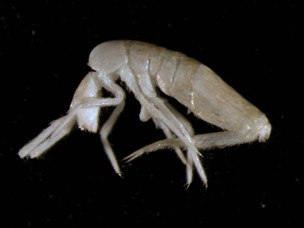Kirk Zigler studies the evolution and development of invertebrate animals, and is particularly interested in cave biodiversity. Contact him for more information about research opportunities in these fields.
Tennessee has more caves than any other state, and Sewanee’s immediate surroundings (Jackson and Madison Counties in Alabama, Franklin and Grundy Counties in Tennessee) support a great diversity of cave animals. Of all 3112 counties in the United States, Jackson County has more species of obligately cave-dwelling animals (troglobionts) than any other. Franklin, Grundy and Madison Counties are all in the top ten of counties nationwide in terms of cave animal diversity. It is not an exaggeration to say that we live precisely on top of the most biodiverse cave systems in the United States.
 Troglobionts are often endemic to one cave or cave system. For example, six of the troglobionts found in Franklin County are known from Franklin County and nowhere else. Due largely to their restricted ranges, 95% of all troglobionts are considered vulnerable or imperiled, and troglobionts make up 50% of all the imperiled species tracked by the U.S. National Heritage Program.
Troglobionts are often endemic to one cave or cave system. For example, six of the troglobionts found in Franklin County are known from Franklin County and nowhere else. Due largely to their restricted ranges, 95% of all troglobionts are considered vulnerable or imperiled, and troglobionts make up 50% of all the imperiled species tracked by the U.S. National Heritage Program.
These diverse and potentially imperiled communities are poorly known. New species are discovered regularly, and little is known about the species that have already been described. They present opportunities for lab and field research such as:
- biological surveys of caves to document regional cave biodiversity
- monitoring troglobionts known from one or a handful of caves, and seeking new populations of rare species
- studies of the reproduction of troglobionts
- using genetics to estimate population sizes, to test for connectivity between cave populations, and to identify relationships between troglobionts and their surface-dwelling relatives
- examining the genetic changes underlying the loss of vision, lack of pigment, and slower life cycles typically observed in troglobionts

